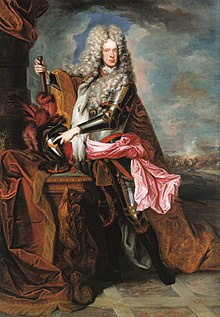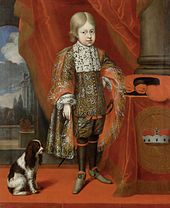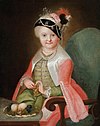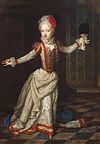| Joseph I | |||||
|---|---|---|---|---|---|
| Imperator Romanorum | |||||
 Portrait by Frans van Stampart, c. 1705 Portrait by Frans van Stampart, c. 1705 | |||||
| Holy Roman Emperor (more...) | |||||
| Reign | 5 May 1705 – 17 April 1711 | ||||
| Predecessor | Leopold I | ||||
| Successor | Charles VI | ||||
| King of Hungary, Croatia and Slavonia | |||||
| Reign | 9 December 1687 – 17 April 1711 | ||||
| Coronation | 9 December 1687 | ||||
| Predecessor | Leopold I | ||||
| Successor | Charles III | ||||
| Co-ruler | Leopold I (1687–1705) | ||||
| Archduke of Austria and King of Bohemia | |||||
| Reign | 5 May 1705 – 17 April 1711 | ||||
| Predecessor | Leopold VI/I | ||||
| Successor | Charles III/II | ||||
| Born | (1678-07-26)26 July 1678 Vienna, Archduchy of Austria, Holy Roman Empire | ||||
| Died | 17 April 1711(1711-04-17) (aged 32) Vienna, Archduchy of Austria, Holy Roman Empire | ||||
| Burial | Imperial Crypt, Vienna | ||||
| Spouse |
Wilhelmine Amalie of Brunswick
(m. 1699) | ||||
| Issue | Maria Josepha, Queen of Poland Archduke Leopold Joseph Maria Amalia, Holy Roman Empress | ||||
| |||||
| House | House of Habsburg | ||||
| Father | Leopold I, Holy Roman Emperor | ||||
| Mother | Eleonore Magdalene of Neuburg | ||||
| Religion | Catholic Church | ||||
| Signature |  | ||||
Joseph I (Joseph Jacob Ignaz Johann Anton Eustachius; 26 July 1678 – 17 April 1711) was Holy Roman Emperor and ruler of the Austrian Habsburg monarchy from 1705 until his death in 1711. He was the eldest son of Leopold I, Holy Roman Emperor from his third wife, Eleonor Magdalene of Neuburg. Joseph was crowned King of Hungary at the age of nine in 1687 and was elected King of the Romans at the age of eleven in 1690. He succeeded to the thrones of Bohemia and the Holy Roman Empire when his father died.
Joseph continued the War of the Spanish Succession, begun by his father against Louis XIV of France, in an attempt to make his younger brother Charles (later Emperor Charles VI) King of Spain. In the process, however, owing to the victories won by his military commander, Prince Eugene of Savoy, he did succeed in establishing Austrian hegemony over Italy. Joseph also had to contend with a protracted revolt in Hungary, fomented by Louis XIV. Neither conflict was resolved until the Treaty of Utrecht, after his death.
His motto was Amore et Timore (Latin for "Through Love and Fear").
Early life

Born in Vienna, Joseph was educated strictly by Charles Theodore, Prince of Salm, and became a good linguist. Perhaps due to the influence of his formerly Protestant tutor he was a less devout Catholic than his parents and other relatives and developed into an adherent of the early Age of Enlightenment. He had two great enthusiasms: music and hunting.
Although Joseph was the first son and child born of his parents' marriage, he was his father's third son and seventh child. Previously, Leopold had been married to Infanta Margaret Theresa of Spain, who had given him four children, one of whom survived infancy. He then married Claudia Felicitas of Austria, who gave him two short-lived daughters. Thus, Joseph had six half-siblings. In 1684, the six-year-old Archduke had his first portrait painted by Benjamin Block. At the age of nine, on 9 December 1687, he was crowned King of Hungary; and at the age of eleven, on 23 January 1690, King of the Romans.
Military service
In 1702, at the outbreak of the War of the Spanish Succession, Joseph saw his only military service. He joined the Imperial General, Louis William, Margrave of Baden-Baden, in the Siege of Landau.
Holy Roman Emperor

Prior to his ascension, Joseph had surrounded himself with reform-hungry advisors and the young court of Vienna was ambitious in the elaboration of innovative plans. He was described as a "forward-looking ruler". The large number of privy councillors was reduced and attempts were made to make the bureaucracy more efficient. Measures were taken to modernize the central bodies and a certain success was achieved in stabilizing the chronically poor Habsburg finances. Joseph also endeavoured to strengthen his position in the Holy Roman Empire – as a means of strengthening Austria’s standing as a great power. When he sought to lay claim to imperial rights in Italy and gain territories for the Habsburgs, he even risked a military conflict with the Pope over the Duchy of Mantua. Joseph I was threatened with excommunication by Pope Clement XI on 16 June 1699.
In Hungary, Joseph had inherited the kuruc rebellion from his father Leopold I: once again, nobles in Transylvania (Siebenbürgen) had risen against Habsburg rule, even advancing for a time as far as Vienna. Although Joseph was compelled to take military action, he refrained – unlike his predecessors – from seeking to teach his subjects a lesson by executing the leaders. Instead, he agreed to a compromise peace, which in the long term facilitated the integration of Hungary into the Habsburg domains. It was his good fortune to govern the Austrian dominions and to be head of the Empire, during the years in which his trusted general, Prince Eugene of Savoy, either acting alone in Italy or with the Duke of Marlborough in Germany and Flanders, was beating the armies of Louis XIV of France. During the whole of his reign, Hungary was disturbed by the conflict with Francis Rákóczi II, who eventually took refuge in the Ottoman Empire. The emperor reversed many of the authoritarian measures of his father, thus helping to placate opponents. He began the attempts to settle the question of the Austrian inheritance by a pragmatic sanction, which was continued by his brother Charles VI.
Religious and ethnic policies
During the Rákóczi's rebellion (1703–1711) in the Kingdom of Hungary, Joseph's government was also faced with various religious and ethnic challenges. Significant portion of Hungarian nobility and people belonged to the Reformed Church (Calvinists). Hoping to gain full religious freedom and equality, Hungarian Calvinists were supportive for the Rákóczi's movement, thus forcing the imperial court in Vienna to reexamine some staunch pro-Catholic policies. In the same time, eastern and southern regions of the Kingdom were also inhabited by Eastern Orthodox Christians, mainly Serbs and Romanians. In order to secure their loyalty, Joseph issued (in 1706) official confirmation of religious liberties that were previously granted to Eastern Orthodox subjects by his father, late emperor Leopold I. In 1708, Joseph confirmed the establishment of the Metropolitanate of Krušedol.
In 1710, Joseph extended his father's edict of outlawry against the Romani (Gypsies) in the Habsburg lands. Per Leopold, any Romani who entered the kingdom was to be declared an outlaw by letters patent. If the same person returned to Bohemia a second time, they were to be "treated with all possible severity". Joseph ordered that in the Kingdom of Bohemia they were to have their right ears cut off; in the Margraviate of Moravia, the left ear was to be cut off; in Austria, they would be branded on the back with a branding iron, representing the gallows. These mutilations were to enable the authorities to identify Romani who had been outlawed and returned. Joseph's edict specified "that all adult males were to be hanged without trial, whereas women and young males were to be flogged and banished forever." Officials who failed to enforce the edict could be fined 100 Reichsthaler. Helping Romani was punishable by a half-year's forced labor. "Mass killings" of Romani were reported as a result.
Death

During the smallpox epidemic of 1711, which killed Louis, Grand Dauphin and three siblings of the future Emperor Francis I, Joseph became infected. He died on 17 April in the Hofburg palace. He had previously promised his wife to stop having affairs, should he survive.
The Emperor was buried in the Imperial Crypt, resting place of the majority of the Habsburgs. His funeral took place on 20 April, in tomb no. 35 in Karl's Vault. His tomb was designed by Johann Lukas von Hildebrandt, decorated with pictures of various battles from the War of Spanish Succession. Josefstadt (the eighth district of Vienna) is named for Joseph.
Marriage and lack of heirs
On 24 February 1699, he married Wilhelmine Amalia of Brunswick-Lüneburg in Vienna. They had three children and their only son died of hydrocephalus before his first birthday. Joseph had a passion for love affairs (none of which resulted in illegitimate children) and he caught a sexually transmittable disease, probably syphilis, which he passed on to his wife while they were trying to produce a new heir. This incident rendered her sterile. Their father, who was still alive during these events, made Joseph and his brother Charles sign the Mutual Pact of Succession, under which Joseph's daughters would have precedence over Charles's daughters, in case neither fathered a son. This ruling, which made no provision for the accession of Charles's daughter Maria Theresa, led to the War of Austrian Succession.
Issue
| Name | Portrait | Lifespan | Notes |
|---|---|---|---|
| Maria Josepha Queen of Poland |

|
8 December 1699 – 17 November 1757 |
Archduchess of Austria, married Augustus III, King of Poland and Elector of Saxony. |
| Leopold Joseph |
29 October 1700 – 4 August 1701 |
Archduke of Austria, died in infancy. | |
| Maria Amalia Holy Roman Empress |

|
22 October 1701 – 11 December 1756 |
Archduchess of Austria, married Charles VII, Holy Roman Emperor |
Ancestors
| Ancestors of Joseph I, Holy Roman Emperor |
|---|
Male-line family tree
References
- Johann Burkhard Mencke; Leben und Thaten Sr. Majestät des Römischen Käysers Leopold des Ersten pg 914 https://books.google.com/books?id=AdhXAAAAcAAJ&q=Josephus+Jacobus+Ignatius+Johannes+Antonius+Eustachius&pg=PA914
- "Joseph I as Roman-German Emperor, oval portrait with motto". The World of the Habsburgs. english.habsburger.net. Archived from the original on July 10, 2012. Retrieved February 18, 2012.
- ^ "Reforming zeal in the Baroque: Joseph I". The World of the Habsburgs. english.habsburger.net. Archived from the original on December 14, 2011. Retrieved February 18, 2012.
- ^
 One or more of the preceding sentences incorporates text from a publication now in the public domain: Chisholm, Hugh, ed. (1911). "Joseph I.". Encyclopædia Britannica. Vol. 15 (11th ed.). Cambridge University Press. p. 514.
One or more of the preceding sentences incorporates text from a publication now in the public domain: Chisholm, Hugh, ed. (1911). "Joseph I.". Encyclopædia Britannica. Vol. 15 (11th ed.). Cambridge University Press. p. 514.
- Joaquín Lorenzo Villanueva, Misapprehension of Patrick Curties and James Doyle concerning the oath which the bishops of Ireland take to the Roman Pontiff, (1825) page 64
- Ingrao 1979, p. 123-160.
- Ćirković 2004, p. 149-150.
- David Crowe (2004): A History of the Gypsies of Eastern Europe and Russia (Palgrave Macmillan) ISBN 0-312-08691-1 p.XI p.36-37
- ^ Genealogie ascendante jusqu'au quatrieme degre inclusivement de tous les Rois et Princes de maisons souveraines de l'Europe actuellement vivans [Genealogy up to the fourth degree inclusive of all the Kings and Princes of sovereign houses of Europe currently living] (in French). Bourdeaux: Frederic Guillaume Birnstiel. 1768. p. 100.
- ^ Eder, Karl (1961), "Ferdinand III.", Neue Deutsche Biographie (in German), vol. 5, Berlin: Duncker & Humblot, pp. 85–86; (full text online)
- ^ Wurzbach, Constantin von, ed. (1861). "Habsburg, Maria Anna von Spanien" . Biographisches Lexikon des Kaiserthums Oesterreich [Biographical Encyclopedia of the Austrian Empire] (in German). Vol. 7. p. 23 – via Wikisource.
- ^ Fuchs, Peter (2001), "Philipp Wilhelm", Neue Deutsche Biographie (in German), vol. 20, Berlin: Duncker & Humblot, p. 384; (full text online)
- ^ Louda, Jirí; MacLagan, Michael (1999). Lines of Succession: Heraldry of the Royal Families of Europe (2nd ed.). London: Little, Brown and Company. table 84.
Sources
- Ćirković, Sima (2004). The Serbs. Malden: Blackwell Publishing. ISBN 978-1-4051-4291-5.
- Herchenhahn, J. C. Geschichte der Regierung Kaiser Josephs I (1786–1789)
- Hochedlinger, Michael (2013). Austria's Wars of Emergence: War, State and Society in the Habsburg Monarchy, 1683–1797. London & New York: Routledge. ISBN 978-1-317-88793-5.
- Ingrao, Charles W. (1979). In Quest and Crisis: Emperor Joseph I and the Habsburg Monarchy. West Lafayette: Purdue University Press. ISBN 978-0-911198-53-9.
- Krones von Marchiand, F. Grundriss der Oesterreichischen Geschichte (1882)
- van Noorden,C. Europäische Geschichte im achtzehnten Jahrhundert (1870–1882).
- Wagner, F. Historia Josephi Caesaris (1746)
External links
![]() Media related to Joseph I, Holy Roman Emperor at Wikimedia Commons
Media related to Joseph I, Holy Roman Emperor at Wikimedia Commons
- Joseph I in the German National Library catalogue
- Joseph I.: "Regina coeli"
- Joseph I (Holy Roman Empire) - MSN Encarta (Archived 2009-10-31)
Regnal titles
| Joseph I, Holy Roman Emperor House of HabsburgBorn: 26 July 1678 Died: 17 April 1711 | ||
| Regnal titles | ||
|---|---|---|
| Preceded byEmperor Leopold I | Holy Roman Emperor King of Bohemia Archduke of Austria Duke of Teschen 1705–1711 |
Succeeded byEmperor Charles VI |
| King of the Romans King in Germany 1690–1711 with Leopold I (1690–1705) | ||
| King of Hungary, Croatia and Slavonia 1687–1711 with Leopold I (1687–1705) | ||
| Holy Roman emperors | |
|---|---|
| |
| Monarchs of Bohemia | ||||||||
|---|---|---|---|---|---|---|---|---|
| Přemyslid |
|  | ||||||
| Non-dynastic |
| |||||||
| Luxembourg |
| |||||||
| Habsburg |
| |||||||
| Non-dynastic |
| |||||||
| Jagiellonian |
| |||||||
| Habsburg |
| |||||||
| Habsburg-Lorraine |
| |||||||
| ||||||||
| Monarchs of Germany | |
|---|---|
| East Francia during the Carolingian dynasty (843–911) | |
| East Francia (911–919) Kingdom of Germany (919–962) | |
| Kingdom of Germany within the Holy Roman Empire (962–1806) |
|
| Confederation of the Rhine (1806–1813) | |
| German Confederation (1815–1848) | |
| German Empire (1848/1849) |
|
| German Confederation (1850–1866) | |
| North German Confederation (1867–1871) | |
| German Empire (1871–1918) | |
| Monarchs of Hungary | ||||||
|---|---|---|---|---|---|---|
| Family tree | ||||||
| House of Árpád |
|  | ||||
| House of Přemysl |
| |||||
| House of Wittelsbach |
| |||||
| Capetian House of Anjou |
| |||||
| House of Luxembourg |
| |||||
| House of Habsburg |
| |||||
| House of Jagiellon |
| |||||
| House of Hunyadi |
| |||||
| House of Jagiellon |
| |||||
| House of Zápolya |
| |||||
| House of Habsburg |
| |||||
| House of Habsburg-Lorraine |
| |||||
| Debatable or disputed rulers are in italics. | ||||||
| Monarchs of Croatia | |
|---|---|
| House of Trpimirović | |
| House of Árpád |
|
| House of Snačić |
|
| Croatia in personal union with Hungary |
|
| House of Savoy-Aosta (Independent State of Croatia) |
|
| Monarchs of Austria | |
|---|---|
| House of Babenberg |
|
| Interregnum |
|
| House of Habsburg Austria |
|
| House of Habsburg Styria, Carinthia, Carniola |
|
| House of Habsburg Tyrol |
|
| Austrian archdukes | |||||||
|---|---|---|---|---|---|---|---|
| Generations are numbered by male-line descent from the first archdukes. Later generations are included although Austrian titles of nobility were abolished in 1919. | |||||||
| 1st generation | |||||||
| 2nd generation | |||||||
| 3rd generation | |||||||
| 4th generation | |||||||
| 5th generation | |||||||
| 6th generation | |||||||
| 7th generation | |||||||
| 8th generation | |||||||
| 9th generation | |||||||
| 11th generation | |||||||
| 12th generation | |||||||
| 13th generation | |||||||
| 14th generation | |||||||
| 15th generation | |||||||
| 16th generation |
| ||||||
| 17th generation |
| ||||||
| 18th generation |
| ||||||
| 19th generation |
| ||||||
| |||||||
- 1678 births
- 1711 deaths
- 18th-century Holy Roman Emperors
- 18th-century archdukes of Austria
- 17th-century Kings of the Romans
- 18th-century monarchs of Bohemia
- 17th-century Hungarian monarchs
- 18th-century Hungarian monarchs
- Nobility from Vienna
- Dukes of Teschen
- Antiziganism in Europe
- Grand masters of the Order of the Golden Fleece
- Knights of the Golden Fleece
- Deaths from smallpox
- Infectious disease deaths in Austria
- Burials at the Imperial Crypt
- Burials at St. Stephen's Cathedral, Vienna
- 17th-century House of Habsburg
- Sons of emperors
- Joseph I, Holy Roman Emperor
- Children of Leopold I, Holy Roman Emperor
- Habsburg monarchs of Bohemia
- Kings of Hungary
- Kings of Croatia